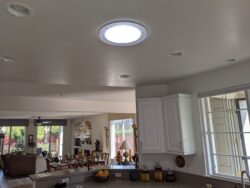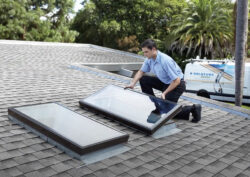Choosing Between Tubular Skylights and Traditional Skylights
When it comes to enhancing the natural light in your home, both a tubular skylight and a traditional skylight offer unique benefits. However, tubular skylights often stand out as the superior option for a variety of reasons. This post will compare these two types of skylights, focusing on installation differences and costs, light distribution and aesthetic considerations, and long-term maintenance and durability, ultimately highlighting why tubular skylights are the better choice.
Comparison of Tubular Skylights and Traditional Skylights
Tubular Skylights:
- Design: Compact, cylindrical structures designed to capture and diffuse sunlight.

- Light Distribution: Highly efficient at channeling natural light into small, dark spaces like hallways, closets, and bathrooms.
- Installation: Minimal structural modifications required, making installation quick and less invasive.
- Cost: Generally more affordable, both in terms of product price and installation costs.
Traditional Skylight:
- Design: Larger, window-like structures that provide direct sunlight and views of the sky.
- Light Distribution: Ideal for larger rooms needing ample daylight, such as living rooms or kitchens.
- Installation: Requires significant roof modifications, potentially impacting structural integrity.
- Cost: Higher initial and installation costs due to the complexity of the installation process.

Installation Differences and Costs
Tubular Skylight:
- Ease of Installation: Tubular skylights are easier and quicker to install because they require less invasive modifications to the roof structure. A small hole is cut in the roof and another in the ceiling, connected by a reflective tube.
- Cost Efficiency: The straightforward installation process results in lower labor costs. Additionally, the materials used in tubular skylights are often less expensive than those for traditional skylights.
- Time: Installation can typically be completed in just a few hours, minimizing disruption to your home life.
Traditional Skylight:
- Complex Installation: Installing traditional skylights involves cutting a large section of the roof, framing the opening, and potentially rerouting electrical or plumbing systems.
- Higher Costs: The need for extensive labor and higher-priced materials leads to greater overall costs. Additional expenses might include drywall repair, painting, and insulation.
- Time-Consuming: The installation process is more time-consuming, often taking several days to complete, which can be disruptive.
Light Distribution and Aesthetic Considerations
Tubular Skylight:
- Even Light Distribution: Tubular skylights use highly reflective tubing to maximize the amount of light delivered into the home. This results in evenly distributed, diffused light that reduces glare and hotspots.
- Subtle Aesthetics: With a low-profile exterior dome and a small interior diffuser, tubular skylights blend seamlessly into most home designs, providing natural light without dominating the space.
- Versatility: They are perfect for illuminating small or awkward spaces where traditional skylights would be impractical.
Traditional Skylight:
- Direct Sunlight: Traditional skylights provide direct, often intense sunlight, which can create glare and increase the risk of fading for furniture and flooring.
- Aesthetic Appeal: While they offer a clear view of the sky and can enhance the aesthetics of a room, they can be visually obtrusive and may not suit all architectural styles.
- Large Spaces: Best suited for large, open areas where the direct influx of sunlight can be diffused naturally within the space.
Long-Term Maintenance and Durability
Tubular Skylight:
- Low Maintenance: Tubular skylights have fewer components exposed to the elements, which reduces wear and tear. The reflective tubing is typically well-sealed, preventing leaks.
- Durability: Made with high-quality, durable materials, tubular skylights are designed to withstand various weather conditions without significant degradation.
- Longevity: With fewer parts that can fail, tubular skylights generally require less frequent maintenance and last longer, providing a reliable source of natural light for years.
Traditional Skylight:
- Regular Maintenance: Due to their larger size and more complex structure, traditional skylights often require more regular maintenance to prevent leaks and condensation.
- Potential for Damage: The larger glass panels are more susceptible to damage from hail, debris, and extreme weather conditions.
- Upkeep Costs: The need for more frequent maintenance and potential repairs can result in higher long-term costs compared to tubular skylights.
Conclusion
While both tubular and traditional skylights can enhance the natural lighting in your home, tubular skylights offer clear advantages in terms of ease of installation, cost efficiency, light distribution, and long-term maintenance. Their ability to provide even, diffused light in a wide range of spaces, combined with their lower impact on your home’s structure and budget, makes tubular skylights the better option for most homeowners. By choosing tubular skylights, you can enjoy the benefits of natural light with minimal hassle and long-term reliability.
